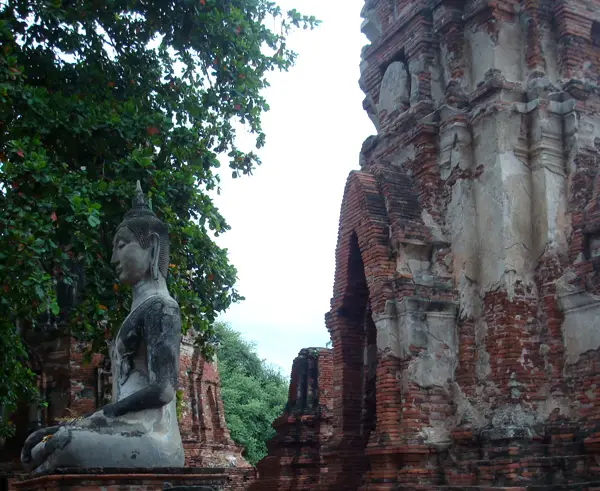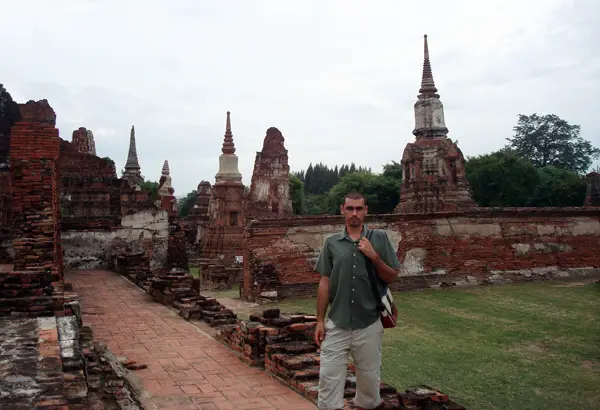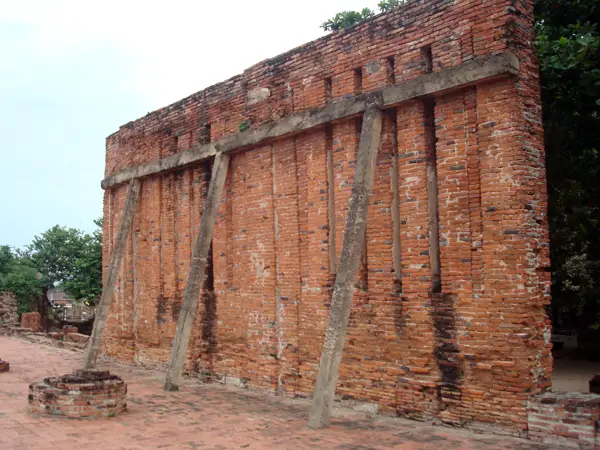At the death of Yamada Nagamasa, the leadership of the Japanese warriors in Ligor passed to Oin, the teenage son of Nagamasa who appears in the records suddenly in 1630. However, endemic rebellions in the region soon forced the Japanese to escape by ship to Cambodia, where they probably merged with the local Japanese community.
In the meantime, probably in February or March 1630, Nagamasa’s junk had returned to Ayutthaya full of goods from the 1629 embassy and of course the Japanese of the Nihonmachi opposed Prasat Thong when he tried to seize the ship and its cargo. In the riot that followed, the Nihonmachi was burnt down by the king’s men. Of the 600 Japanese who supposedly inhabited it then, only 60 to 70 returned to Japan just in time before the Tokugawa shut their doors to the outside world for the next 250 years.
The testimony written by Chihara Gorohachi in Tsuko Ichiran recounts a verbal struggle between Prasat Thong and Iwakura Heymon, the new headman of Ayutthaya’s Nihonmachi. After a few scuffles and some display of martial honour (the Japanese were seemingly ready for “a noble ending with arms in their hands”), the events culminated in a furious naval battle, as the Japanese fled on their vessels, bound for Japan.
Later, in 1630, the Japanese who were in Cambodia (including very possibly Oin, his men, and some who had escaped from Ayutthaya) sided with their new adoptive kingdom when its navy attacked Siam at the mouth of Menam. We can assume that at this point most of the Japanese who were left in Siam were massacred, however, some of the warriors were promptly re-enrolled in Prasat Thong’s army.
Prasat Thong realized that he was losing a precious ally, and tried to re-open Ayutthaya to the Japanese. Even when only a few moved back to the Siamese capital, in 1632 Antonio Cean recorded the existence of a Nihonmachi. In 1633, a peace agreement was reached by Cambodia and Siam and a few more Japanese returned to Ayutthaya.
Nevertheless, the Nihonmachi was never again to enjoy the prosperity it had experienced during the days of Kyuemon and Nagamasa. By the mid-1930s, Japan had locked its borders for good and no more ships carrying Japanese merchants sailed to Southeast Asian waters. Commerce continued on a smaller scale, with ships manned for the most part by Chinese sailors travelling between Nagasaki and other Asian ports to trade and gather intelligence for the Japanese.
Prasat Thong numerous attempts to re-establish relations were regularly frustrated: in 1636, his second embassy failed to explain the circumstances of the death of Nagamsa, and was sent home with a letter that ridiculed the Siamese king. His killing of Nagamasa and many other Japanese residents in Siam was never forgiven by the shogunate: in Edo, matters of principle seemingly counted for more than business.
Without the support of their motherland, the business that had been pumping funds and energy into the community could not flourish anymore, and the few Japanese who lived there blended with the local population. We know very little of a few other Japanese headmen, some of whom were involved in the coup that brought King Narai to power in 1656. One of them, Antonio Zenzaemon, was in all probability a Christian, who may have lived with part of the Japanese community alongside the Portuguese.
Among the few names that emerged from late 17th-century’s scant sources, there is also the mention of a woman called Ursula Yamada. It is not sure that she was related to Nagamasa, since Yamada was – and still is today – a vey common family name in Japan.
The last mention of Japanese in Ayutthaya is dated June 5, 1688.On that day Constantine Phaulkon (a Greek adventurer, who became first counsellor to King Narai of Ayutthaya) was executed and some of his relatives, including his half-Japanese wife, took refuge in whatever was left of the Nihonmachi.
A few decades later, the Japanese quarter was no more. During the Spanish embassy led by Bustamante to Siam in 1718, a treaty (probably meaning a verbal agreement) was concluded, and one of the terms was the concession of a piece of land “that before was called the ‘Japanese camp’ and is now called Nuestra Senora del Soto y S. Buenaventura (facing the Portuguese camp and separated from the Dutch camp by a small canal).” The Spanish were not there for long, since we know that around the middle of the 18th-century the plot of land that was once commanded by Nagamasa was occupied by the Cochinchinese.
Then, in 1767, Ayutthaya was conquered and sacked by the Burmese. After they left with booty and captives, the city was reduced to ashes and transformed into a ghost town. Recovery was slow, and Ayutthaya is still today a minor center, counting a population of only 60,000.
There is one last piece of interesting information regarding the Japanese in Siam before the normalization of relationship between Japan and Thailand in 1887. Edmund Roberts, the U.S. envoy who visited Bangkok in 1833 to conclude a treaty of friendship and trade between the U.S and Siam, returned to Bangkok in April 1836 for the exchange of ramifications of the 1833 treaty. A collection of Thai documents contains a memorandum with the instructions of King Rama III for arranging an audience. This memorandum shows that a special unit of guards called “Japanese Auxiliaries” (asa yipun) still existed at the time, consisting of 100 soldiers and two officers. It also says that their uniforms were Chinese in style. We don’t know whether among these guards there were any of the descendants of Nagamasa and his men. However, it is clear that the tradition, or perhaps only the ideal, of hiring Japanese auxiliaries in the royal army lived on until at least the mid-19th century.
Resources: “Samurai of Ayutthaya – The Historical Landscape of
Early 17th Century Japan and Siam: Yamada Nagamasa
and the Way to Ayutthaya” by Cesare Polenghi (p. 60-64)




